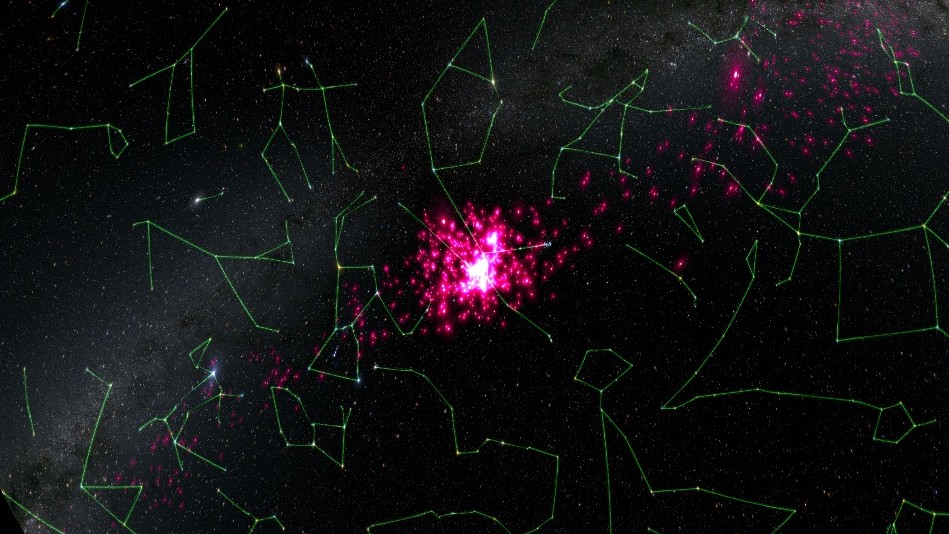Lopsided star cluster may disprove Newton and Einstein, controversial new study claims
An uneven distribution of stars in several nearby clusters may offer evidence of MOND – a controversial theory of gravity that disputes Newton and rejects the existence of dark matter.

Astronomers observing star clusters in our galaxy have found evidence that controversially challenges Newton's laws of gravity and could upend our understanding of the universe. The puzzling finding could support a controversial idea that does away entirely with dark matter.
The researchers found this evidence by observing open star clusters, or loosely bound groups of up to a few hundred stars sitting within larger galaxies. Open star clusters have trails of stars, known as "tidal tails," in front of and behind them. The researchers' observations indicate that such clusters have many more stars sitting in the overall direction of their travel through space than trailing behind. This throws into question Newton's law of universal gravitation, which suggests that there should be the same number of stars in both tidal tails.
"It's extremely significant," astrophysicist Pavel Kroupa of the University of Bonn told Live Science. "There is a huge effect."
Kroupa is the lead author of a study published Oct. 26 in the Monthly Notices of the Royal Astronomical Society that argues the observations are evidence of modified Newtonian dynamics (MOND) — an alternative theory of gravity to Newton's widely accepted universal law of gravitation.
This uneven distribution of stars is noticeable, but not extreme enough for any sort of dark matter — an invisible substance thought to exert a powerful gravitational pull on the universe's visible matter — to be involved, Kroupa said.
"This is basically a game-changer," he said. "This destroys all the work done on galaxies and on cosmology [that] assumes dark matter and Newtonian gravity."
Get the world’s most fascinating discoveries delivered straight to your inbox.
Dark matter?
Issac Newton's universal law of gravitation, published in 1687, states that every particle in the universe attracts every other with a force proportional to their masses and inversely proportional to the square of their distance. Albert Einstein later incorporated this law into his theory of general relativity, which was published in 1915.
But Kroupa said that at the time of both Newton and Einstein, astronomers didn't know that galaxies even existed, and so MOND was developed to bring it up to date with observations.
MOND, also known as Milgromian dynamics after astrophysicist Mordehai Milgrom who developed it in the early 1980s, argues that regular Newtonian dynamics don't apply on the very large scales of galaxies and galactic clusters — although most astrophysicists think they do.
The main consequence of MOND is that dark matter doesn't exist — an idea that most astrophysicists dismiss, Kroupa said. "The majority of scientists completely reject Mond," he said. "Many serious scientists don't think Mond is serious, and so they wouldn't consider looking at it."
Stellar clusters
In their study, the authors report observations of five of the closest open stellar clusters to Earth, including the Hyades — a roughly spherical group of hundreds of stars that is only about 150 light-years from our sun.
The researchers observed that stars had accumulated in the leading tidal tail in all five of the clusters, while the greatest discrepancy from regular Newtonian dynamics was seen in the Hyades cluster, where there are better measurements, Kroupa said.
The observed discrepancies strengthen the case for MOND, but they can't be a result of the invisible action of dark matter.
In the case of the Hyades, "we would have to have a clump of dark matter there like 10 million solar masses" to explain the results, he said. "But it's just not in the data."
Future studies will use more precise data on the positions of stars from new space telescopes, such as the European Space Agency's Gaia, he said.
However, because MOND is not widely accepted by many scientists, the new study's findings are controversial.
Sabine Hossenfelder, an astrophysicist at the Frankfurt Institute Advanced Studies, told Live Science in an email that she was pleased to see researchers working on gravitational simulations of MOND.
But "as they admit the paper themselves, they are using an approximate calculation that needs to be confirmed… [and] they haven't quantified how large the disagreement with data is," she said. "So I think it remains to be seen how good this argument actually is."
Tom Metcalfe is a freelance journalist and regular Live Science contributor who is based in London in the United Kingdom. Tom writes mainly about science, space, archaeology, the Earth and the oceans. He has also written for the BBC, NBC News, National Geographic, Scientific American, Air & Space, and many others.



